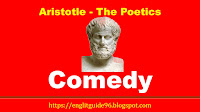Aristotle
- The Poetics
Theory of Fine arts
Aristotle’s Poetics is a treatise of about
fifty pages, containing twenty-six small chapters. It gives the impression of
being a summary of his lectures to his disciples, written either by them or by
him. It is believed to have had a second part, which is lost. For, it is
incomplete and omits some of the important questions he himself raises, which
were reserved for a fuller treatment in the second part. The first four
chapters and the twenty-fifth are devoted to poetry, the fifth in a general way
to comedy, epic and tragedy, the following fourteen exclusively to tragedy, the
next three to poetic diction, the next two to epic poetry, and the last to a comparison
of epic poetry and tragedy, which in his day was considered to be the most developed
form of poetry. Aristotle’s Poetics is a window to peep through the world of
criticism and to study deeply, read and discuss the different genres of
literature especially tragedy, comedy and epic.
The
term ‘fine art’ is not one that has been transmitted to us from the Greeks.
Their phrase was the ‘imitative arts’, ‘modes of imitation’, or sometimes the
‘liberal arts’. ‘Imitation’ was not originated by Aristotle. In literature the
phrase first occurs in Plato. According to Aristotle, the artist may ‘imitate
things as they ought to be’; he may place before him an unrealized ideal.
A work
of art is a reproduction of an original and not a symbolic representation of
it; and this holds good whether the artist draws from a model in the real world
or from an unrealized ideal in the mind. The spoken words are symbols of mental
states, written words are symbols of spoken words; the connection between them
is conventional. On the other hand, mental impressions are not signs or
symbols, but copies of external reality, likeness of the things themselves. In
the act of sensuous perception objects stamp upon the mind an impress of themselves
like that of a signet ring, and the picture so engraved on the memory is
compared to a portrait.
‘To
imitate nature’ is not the function of fine art. The actual objects of
aesthetic imitation are threefold: the characteristic moral qualities, the
permanent disposition of the mind, the more transient emotions, the passing
moods of feeling; actions in their proper and inward sense. An act viewed
merely as an external process or result, is not the true object of aesthetic
imitation.
Everything
that expresses the mental life will fall within the ‘action’. Such actions are
not necessarily processes extending over a period of time: they may realize
themselves in a single moment; they may be summed up in a particular mood, a
given situation.






















0 Comments